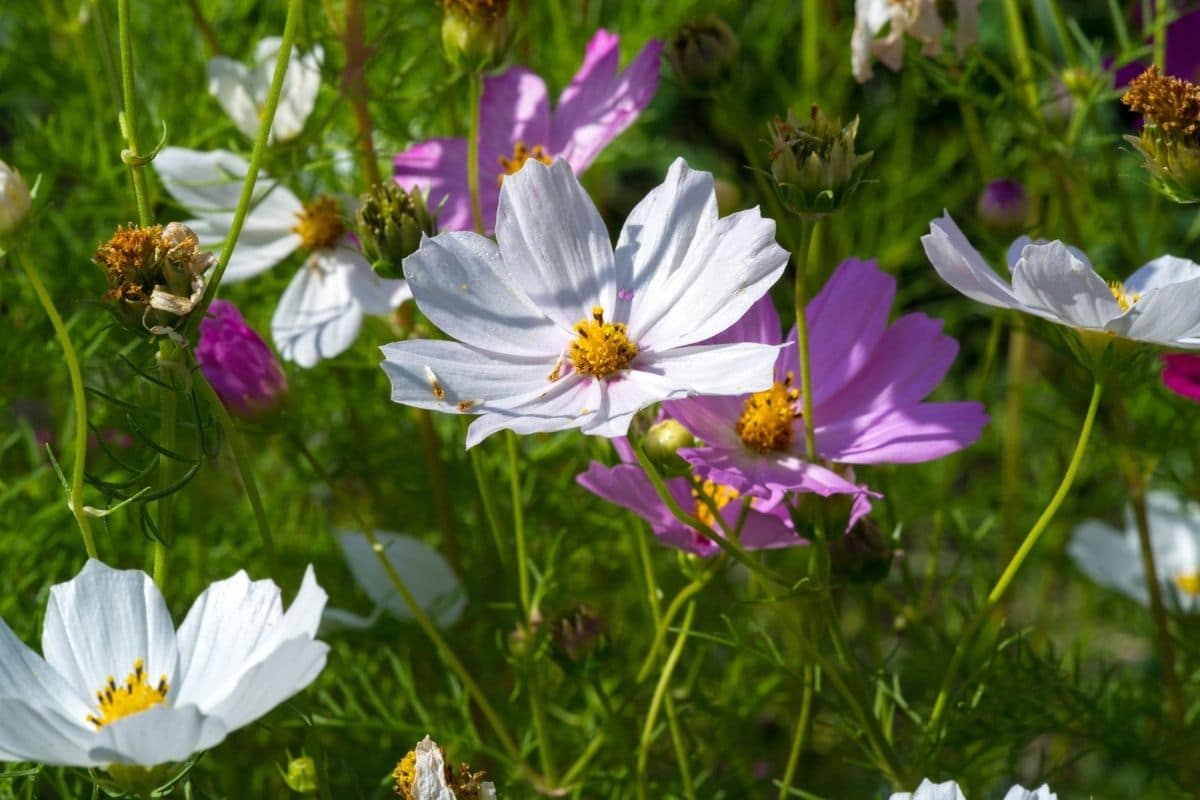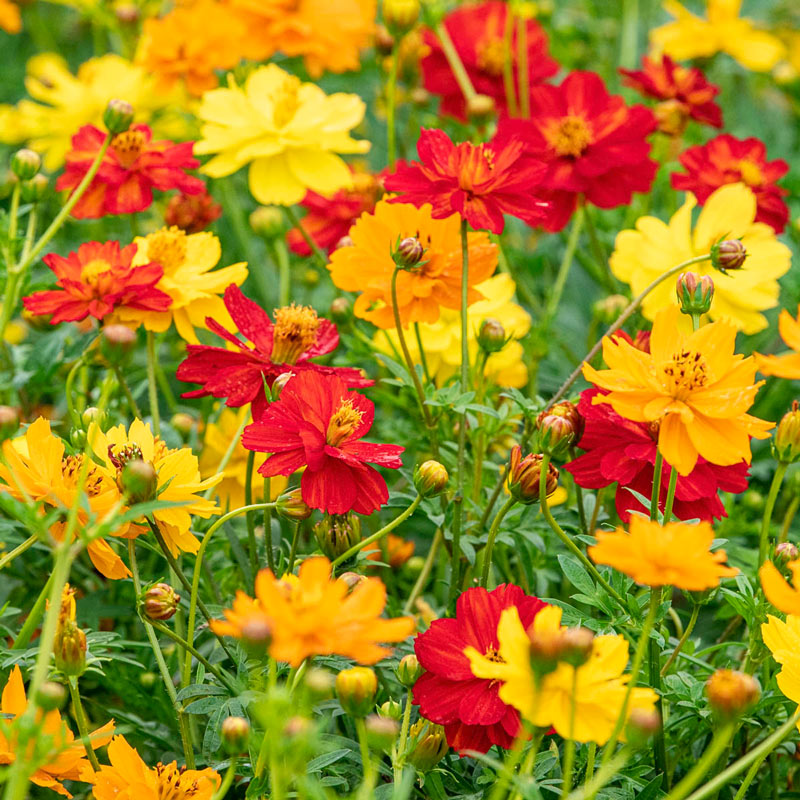Understanding the Life Cycle of Cosmos
Cosmos flowers, known for their dainty, feathery foliage and vibrant blooms, have a relatively short life cycle compared to other annuals. The journey from seed to bloom typically spans around 60 to 90 days, depending on factors such as weather, soil quality, and light exposure. To answer the question of how long do cosmos take to bloom, it’s essential to understand the three main stages of their life cycle: germination, growth, and blooming.
Germination, the initial stage, usually occurs within 7 to 10 days after sowing seeds. During this period, the seeds absorb water, and the embryo begins to grow. The growth stage, which follows germination, can last anywhere from 30 to 60 days. This is the period when the seedlings develop their root system, produce leaves, and start to grow stems. The blooming stage, the final stage, typically lasts around 30 to 60 days, depending on the variety and growing conditions.
Several factors can influence the blooming time of cosmos flowers, including temperature, moisture, and sunlight. For instance, cosmos flowers typically thrive in temperatures between 65°F to 75°F (18°C to 24°C). Prolonged exposure to extreme temperatures can delay or accelerate blooming. Similarly, adequate moisture and sunlight are crucial for healthy growth and blooming. Cosmos flowers require at least 6 hours of direct sunlight per day to produce an abundance of blooms.
By understanding the life cycle of cosmos flowers and the factors that influence their blooming time, gardeners can better plan and care for their cosmos plants. This knowledge can help answer the question of how long do cosmos take to bloom and ensure a successful and rewarding growing experience.
Factors Affecting Cosmos Blooming Time
Temperature, moisture, and sunlight are the primary factors that impact the blooming time of cosmos flowers. Understanding how these factors influence blooming can help gardeners optimize growing conditions and answer the question of how long do cosmos take to bloom.
Temperature plays a significant role in cosmos blooming time. Most cosmos varieties thrive in temperatures between 65°F to 75°F (18°C to 24°C). Prolonged exposure to temperatures above 85°F (29°C) can lead to delayed blooming, while temperatures below 55°F (13°C) can slow down growth. Some cosmos varieties, such as ‘Sensation’ and ‘Purity’, are more tolerant of cooler temperatures and can bloom earlier than others.
Moisture is another critical factor that affects cosmos blooming time. Cosmos flowers require consistent moisture, especially during the germination and growth stages. Drought can delay blooming, while overwatering can lead to root rot and poor flower quality. Gardeners can ensure optimal moisture levels by watering cosmos plants regularly and providing adequate drainage.
Sunlight is essential for cosmos blooming, as it provides the energy needed for photosynthesis and flower production. Cosmos flowers require at least 6 hours of direct sunlight per day to produce an abundance of blooms. However, some varieties, such as ‘Sea Shells’ and ‘Rubenza’, can tolerate partial shade and still produce a decent number of flowers.
In addition to temperature, moisture, and sunlight, other factors can influence cosmos blooming time, such as soil quality, fertilization, and pruning. By understanding how these factors interact and impact blooming, gardeners can create optimal growing conditions and enjoy a longer blooming season.
How to Create Optimal Growing Conditions for Cosmos
Creating optimal growing conditions is crucial for cosmos flowers to bloom successfully. By providing the right environment, gardeners can encourage healthy growth, promote blooming, and answer the question of how long do cosmos take to bloom.
Soil preparation is essential for cosmos flowers. They prefer well-draining soil with a pH between 6.0 and 7.0. Adding organic matter such as compost or manure can improve soil fertility and structure. Cosmos flowers also benefit from a balanced fertilizer, applied once a month, to promote healthy growth and blooming.
Watering is another critical aspect of cosmos care. These flowers require consistent moisture, especially during the germination and growth stages. However, overwatering can lead to root rot and poor flower quality. Gardeners can ensure optimal moisture levels by watering cosmos plants regularly and providing adequate drainage.
Adequate sunlight is also essential for cosmos blooming. These flowers require at least 6 hours of direct sunlight per day to produce an abundance of blooms. However, some varieties can tolerate partial shade and still produce a decent number of flowers. Providing support for tall varieties, such as ‘Sensation’ and ‘Purity’, can also promote healthy growth and blooming.
In addition to soil preparation, watering, and sunlight, cosmos flowers also benefit from regular fertilization and pruning. Fertilizing once a month can promote healthy growth and blooming, while pruning can encourage bushy growth and prevent the plants from becoming leggy.
By creating optimal growing conditions, gardeners can encourage healthy growth, promote blooming, and enjoy a longer blooming season. With proper care and attention, cosmos flowers can bloom for several weeks, providing a stunning display of color and beauty in the garden.
Cosmos Varieties: Which Ones Bloom the Fastest?
With over 20 species of cosmos flowers, gardeners have a wide range of options to choose from when it comes to blooming times. Some varieties, such as ‘Sensation’ and ‘Purity’, are known to bloom quickly, while others, like ‘Sea Shells’ and ‘Rubenza’, take a bit longer. Understanding the blooming times of different cosmos varieties can help gardeners plan their garden and answer the question of how long do cosmos take to bloom.
‘Sensation’ cosmos, for example, are known to bloom in as little as 60 days, producing vibrant pink and white flowers. ‘Purity’ cosmos, on the other hand, take around 70 days to bloom, producing pure white flowers with a delicate pink center. Both of these varieties are great options for gardeners who want to see quick results.
Other popular cosmos varieties include ‘Sea Shells’, which take around 80 days to bloom, producing delicate pink and white flowers with a shell-like shape. ‘Rubenza’ cosmos, which take around 90 days to bloom, producing vibrant red and pink flowers. These varieties are great options for gardeners who want to add a pop of color to their garden later in the season.
In addition to these popular varieties, there are many other cosmos varieties to choose from, each with their own unique blooming times and characteristics. By choosing the right variety for their garden, gardeners can enjoy a longer blooming season and add beauty and color to their outdoor space.
When choosing a cosmos variety, gardeners should consider factors such as blooming time, flower color, and growth habit. By selecting a variety that meets their needs and preferences, gardeners can ensure a successful and enjoyable growing experience.
How to Care for Cosmos During the Blooming Stage
Once cosmos flowers have reached the blooming stage, they require regular care to maintain their health and promote continued blooming. Proper care during this stage can help answer the question of how long do cosmos take to bloom and ensure a longer blooming season.
Deadheading is an essential part of cosmos care during the blooming stage. Removing spent flowers, also known as deadheading, encourages the plant to produce more blooms and prevents seed production. This process can be done by simply snipping off the spent flowers with scissors or pinching them off with your fingers.
Pruning is another important aspect of cosmos care during the blooming stage. Pruning helps to maintain the plant’s shape, promotes healthy growth, and encourages more blooms. Cosmos plants can be pruned back by about one-third to one-half to encourage bushy growth and prevent them from becoming leggy.
Pest management is also crucial during the blooming stage. Cosmos plants can be susceptible to pests such as aphids, whiteflies, and spider mites. Regularly inspecting the plants and treating any infestations promptly can help prevent damage and promote healthy growth.
Maintaining soil moisture is also essential during the blooming stage. Cosmos plants require consistent moisture, especially during hot and dry weather. Watering the plants regularly and providing adequate drainage can help prevent root rot and promote healthy growth.
Fertilizing regularly is also important during the blooming stage. Cosmos plants benefit from regular fertilization, which can help promote healthy growth and blooming. A balanced fertilizer can be applied once a month to provide the necessary nutrients for the plants.
By following these care tips, gardeners can help promote healthy growth and blooming in their cosmos plants. With proper care and attention, cosmos flowers can bloom for several weeks, providing a stunning display of color and beauty in the garden.
Troubleshooting Common Issues with Cosmos Blooming
Despite proper care and attention, cosmos flowers can still experience issues that affect their blooming. Delayed blooming, poor flower quality, and lack of blooms are common problems that can arise. Understanding the causes of these issues and knowing how to troubleshoot them can help gardeners overcome these challenges and answer the question of how long do cosmos take to bloom.
Delayed blooming can be caused by a variety of factors, including weather conditions, soil quality, and inadequate sunlight. To address this issue, gardeners can try providing supplemental lighting, adjusting soil pH, or using row covers to extend the growing season.
Poor flower quality can be caused by factors such as inadequate fertilization, pests, or diseases. To address this issue, gardeners can try fertilizing regularly, using organic pest control methods, and practicing good sanitation techniques.
Lack of blooms can be caused by factors such as inadequate sunlight, poor soil quality, or inadequate watering. To address this issue, gardeners can try providing supplemental lighting, adjusting soil pH, or increasing watering frequency.
By understanding the causes of common issues with cosmos blooming and knowing how to troubleshoot them, gardeners can overcome these challenges and enjoy a successful and rewarding growing experience. With proper care and attention, cosmos flowers can bloom for several weeks, providing a stunning display of color and beauty in the garden.
In addition to these troubleshooting tips, gardeners can also try using cosmos varieties that are known to be more resistant to common issues. Some popular varieties include ‘Sensation’, ‘Purity’, and ‘Sea Shells’, which are known for their robust growth and high-quality blooms.
By combining good gardening practices with the right variety selection, gardeners can enjoy a successful and rewarding growing experience with cosmos flowers.
Extending the Blooming Season of Cosmos
While cosmos flowers are known for their relatively short blooming season, there are several strategies that can be used to extend the blooming period and encourage repeat blooming. By implementing these techniques, gardeners can enjoy a longer blooming season and answer the question of how long do cosmos take to bloom.
Succession planting is one technique that can be used to extend the blooming season of cosmos flowers. This involves planting multiple batches of cosmos seeds at intervals of 1-2 weeks, which can help to ensure a continuous supply of blooms throughout the growing season.
Providing support for tall varieties of cosmos is another technique that can help to extend the blooming season. By providing a trellis or stake for the plants to climb on, gardeners can help to promote healthy growth and encourage more blooms.
Using row covers is another technique that can help to extend the blooming season of cosmos flowers. Row covers can help to protect the plants from frost and other extreme weather conditions, which can help to prolong the blooming period.
In addition to these techniques, gardeners can also try using cosmos varieties that are known to be more resistant to extreme weather conditions. Some popular varieties include ‘Sensation’, ‘Purity’, and ‘Sea Shells’, which are known for their robust growth and high-quality blooms.
By combining these techniques with good gardening practices, gardeners can enjoy a longer blooming season and more blooms from their cosmos flowers. With proper care and attention, cosmos flowers can bloom for several weeks, providing a stunning display of color and beauty in the garden.
Extending the blooming season of cosmos flowers can also be achieved by providing the right growing conditions. This includes providing adequate sunlight, water, and nutrients, as well as protecting the plants from pests and diseases.
Enjoying the Fruits of Your Labor: Cosmos Blooming Time
After weeks of careful planning, planting, and tending, the moment of truth has finally arrived – your cosmos flowers are in bloom With their delicate, feathery foliage and vibrant, dainty blooms, cosmos flowers are a true delight to behold. And with a little creativity, you can enjoy their beauty in a variety of ways.
One of the simplest ways to enjoy your cosmos blooms is to use them in floral arrangements. Simply snip off a few stems, add some greenery like ferns or lemon leaves, and you’ve got a beautiful, delicate arrangement that’s perfect for brightening up any room.
Cosmos flowers also make excellent cut flowers. Simply snip off the stems, place them in a vase, and enjoy their beauty for days to come. You can also add some decorative elements like ribbons or twine to give your arrangement a more rustic, homespun feel.
In addition to using cosmos flowers in arrangements and as cut flowers, you can also incorporate them into your garden design. Try planting them in a border or container, where their delicate foliage and vibrant blooms can add a pop of color and texture to your outdoor space.
By enjoying the fruits of your labor and finding creative ways to use your cosmos blooms, you can extend the pleasure of growing these beautiful flowers and make the most of your gardening experience. And with a little practice and patience, you’ll be able to answer the question of how long do cosmos take to bloom with confidence and enjoy a bountiful harvest of beautiful blooms.
So why not get creative and find new ways to enjoy your cosmos blooms? With their delicate beauty and vibrant colors, they’re sure to bring a smile to your face and a touch of elegance to any room or outdoor space.







